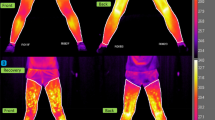Abstract
The purposes of the present study were to examine the response of the skin blood flux (SBF) in the paralyzed lower limbs of persons with spinal cord injury (PSCI) and to clarify the relationship between the SBF and core temperature during prolonged arm exercise. Eight male PSCI with lesions from T6 to L5 and six male control subjects (CS) participated in this study. The subjects rested for 60 min and then performed arm-cranking exercise at 20 W for 30 min at 25 °C. The tympanic membrane temperature (T ty) and SBF in the anterior thigh (SBFT) and in the posterior calf (SBFC) were continuously measured throughout the experiment. The SBFC did not change in either PSCI or CS during the experiment. The SBFT in four PSCI with high lesions (T6 to T12), remained unchanged during exercise. The SBFT in the other four PSCI with low lesions (T12 to L5, ΔSBFT+) began to elevate markedly when the T t, exceeded a threshold temperature of 36.69 °C. The pattern of increase of SBFT in ΔSBFT+ was similar to that in CS, although onset of the increase in SBFT was delayed and the peak of SBFT during exercise was significantly lower in comparison with the CS. We consider that these differences between the ΔSBFT+ and CS were largely attributable to the lowerT ty in the former group, which took a prolonged time to reach the threshold of 36.69 °C.
Similar content being viewed by others
References
Attia M, Engel P (1983) Thermoregulatory set point in patients with spinal cord injuries (spinal man). Paraplegia 21:233–248
Essandoh LK, Duprez DA, Shepherd JT (1987) Postural cardiovascular reflexes: comparison of responses of forearm and calf resistance vessels. J Appl Physiol 63:1801–1805
Fitzgerald PI, Sedlock DA, Knowlton RG (1990) Circulatory and thermal adjustments to prolonged exercise in paraplegic women. Med Sci Sports Exerc 22:629–635
Guttmann L, Silver J, Wyndham CH (1958) Thermoregulation in spinal man. J Physiol 142:406–419
Hammel HT, Jackson DC, Stolwijk JAJ, Hardy JD, Strømme SB (1963) Temperature regulation by hypothalamic proportional control with an adjustable set point. J Appl Physiol 18:1146–1154
Ishii K, Yamasaki M, Muraki S, Komura T, Kikuchi K, Maeda K (1994) Exercise-induced temperature changes in the tympanic membrane and skin of patients with spinal cord injury. In: Yabe K, Kusano K, Nakata H (eds) Adapted physical activity. Springer, Berlin Heidelberg New York, pp 77–83
Ishii K, Yamasaki M, Muraki S, Komura T, Kikuchi K, Miyagawa T, Fujimoto S, Maeda K (1995) Tympanic temperature and skin temperatures during upper limb exercise in patients with spinal cord injury. Jpn J Phys Fitness Sports Med 44:447–456
Johnson JM, Park MK (1981) Effect of upright exercise on threshold for cutaneous vasodilation and sweating. J Appl Physiol 50:814–818
Johnson JM, Rowell LB (1975) Forearm skin and muscle vascular responses to prolonged leg exercise in man. J Appl Physiol 39:920–924
Johnson JM, Taylor WF, Shepherd AP, Park MK (1984) Laser-Doppler measurement of skin blood flow: comparison with plethysmography. J Appl Physiol 56:798–803
Kenney WL, Johnson JM (1992) Control of skin blood flow during exercise. Med Sci Sports Exerc 24:303–312
Kellogg DL, Johnson JM, Kosiba WA (1991) Control of internal temperature threshold for active cutaneous vasodilation by dynamic exercise. J Appl Physiol 71:2476–2482
Masuda M, Uchino K (1978) A device for tympanic membrane temperature in man. Jikeikai Med J 25:95–99
Mollinger LA, Spurr GB, El Chatit AZ, Barboriak JJ, Rooney CB, Davidoff DD, Bongard RD (1985) Daily energy expenditure and basal metabolic rates of patients with spinal cord injury. Arch Phys Med Rehabil 66:420–426
Muraki S, Yamasaki M, Ishii K, Kikuchi K, Seki K (1995) Effect of arm cranking exercise on skin blood flow of lower limb in people with injuries to the spinal cord. Eur J Appl Physiol 71:28–32
Nishiyasu T, Shi X, Gillen CM, Mack GW, Nadel ER (1992) Comparison of the forearm and calf blood flow response to thermal stress during dynamic exercise. Med Sci Sports Exerc 24:213–217
Normell LA (1974) Distribution of impaired cutaneous vasomotor and sudomotor function in paraplegic man. Scand J Clin Lab Invest 33 [Suppl 138]:25–11
Petrofsky IS (1992) Thermoregulatory stress during rest and exercise in heat in patients with a spinal cord injury. Eur J Appl Physiol 64:503–507
Saumet JL, Kellogg DL Jr, Taylor WF, Johnson JM (1988) Cutaneous laser-Doppler flowmetry: influence of underlying muscle blood flow. J Appl Physiol 65:478–481
Taylor JA, Joyner MJ, Chase PB, Seals DR (1989) Differential control of firearm and calf vascular resistance during one-leg exercise. J Appl Physiol 67:1791–1800
Totel GL, Johnson RE, Fay FA, Goldstein JA, Schick J (1971) Experimental hyperthermia in traumatic quadriplegia. Int J Biometeorol 15:346–355
Wenger CB, Roberts MF, Stolwijk JAJ, Nadel ER (1975) Forearm blood flow during blood temperature transients produced by leg exercise. J Appl Physiol 38:58–63
Author information
Authors and Affiliations
Rights and permissions
About this article
Cite this article
Muraki, S., Yamasaki, M., Ishii, K. et al. Relationship between core temperature and skin blood flux in lower limbs during prolonged arm exercise in persons with spinal cord injury. Europ. J. Appl. Physiol. 72, 330–334 (1996). https://doi.org/10.1007/BF00599693
Accepted:
Issue Date:
DOI: https://doi.org/10.1007/BF00599693




